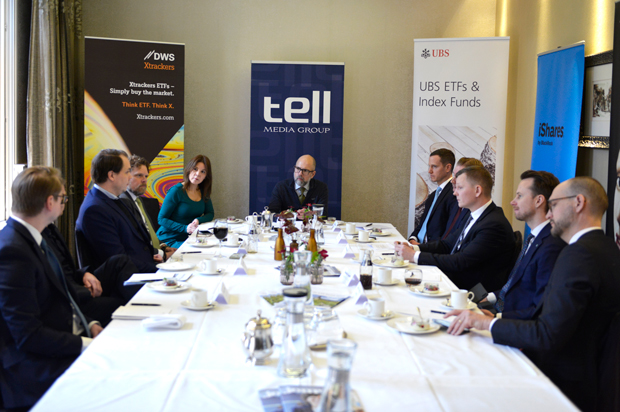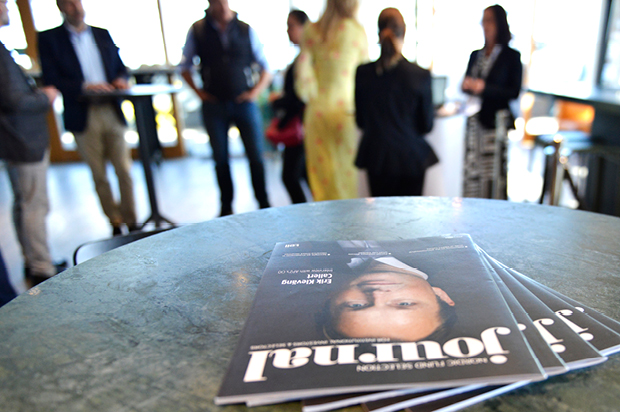
Sustainability, regulation and fixed income in focus
Earlier this year, Tell Media Group, in co-operation with Blackrock, DWS Xtrackers, Invesco, JPMorgan Asset Management and UBS Asset Management, invited Finnish investors to discuss trends within the ETF industry at Hotel Kämp in central Helsinki.
The discussion started with Caroline Liinanki asking the investors at the table how they are currently using ETFs and if this has changed over time.
JONI LESKINEN: “In our multi-asset portfolios, the weight of our own funds are roughly 50 per cent and the rest consists of ETFs. So we use a lot of ETFs and have done so for a long time. The exposure to ETFs has not changed dramatically over the years but how we do it has. Today, we take a more active approach, for example when it comes to index selection and ESG. We’re simply more active today in the selection of ETFs we use.”
MARKKU LEPPÄLÄ: “My area of expertise is emerging markets within equities and we use ETFs mostly in emerging markets. We need ETFs for both strategical and tactical risk taking. We have a broad exposure to emerging markets via ETFs to track the benchmark and if we want to take a tactical position, for example in Brazil, it’s quick and easy to make a switch between ETFs, meaning, selling some of the broad ETF exposure and investing in a Brazil ETF.”
MARKO ALARAATIKKA: “In the wealth management at S-Pankki, we manage a lot of customer mandates. We use, of course, a lot of in-house funds but we’ve seen an increased demand for ETF solutions and we’ve introduced some model portfolios where we only use ETFs. That has been a change. We´ve been doing this for little over two years now. Markets have been very tactically driven and that’s probably one reason for the increased interest.”
MIKAEL LÖFBERG: “We haven’t seen any big changes more recently. We still have some 30 per cent of assets invested in ETFs across our different strategies. If I look at what we did last year, it clearly reflects what the others have already said in that we were more active in our ETFs, so using them to express our tactical views. We use active managers as our core holdings.”
FLORIAN CISANA: “I think that when clients are searching for investment solutions to invest in markets, they first decide if they want to invest in an actively or in a passively managed instrument. Clients choose passive solutions because of market efficiency, tactical need of the investment, costs and/or other reasons. The second decision is on how clients access the passive exposure and here ETFs are besides index funds, discretionary portfolios, futures and swaps, one of many solutions. However, ETFs do offer some unique features to clients, such as secondary market liquidity, iNAV, basket disclosure, easy access and more. That’s important to some clients and not least when you want to take tactical positions, meaning trading in and out of a market within a short period. As more and more clients get familiar with these added benefits of the ETF wrapper, which is not about active versus passive, we’re seeing more and more clients also interested in getting active exposure in an ETF wrapper.”
MIKAEL LÖFBERG: “It’s easy to agree with that. I like that I can click into my Bloomberg and buy or sell the ETF. It gives satisfaction seeing the trade being executed straight away.”
TOBIAS NILSSON: “The ETF has brought a lot of efficiencies to the market – transparency as you mentioned, execution cost and liquidity but also as a benchmark for active performance over time. Now it’s providing even more choices as both passive and active strategies are available in the ETF wrapper. It’s up to our fund selectors to evaluate but from a sustainability perspective, we’ve seen flows favouring active. This year actively-managed ETFs are really taking off and sustainability may be one of the factors, at least in Europe.”
NIKLAS TELL: PETER, WHAT ARE YOU SEEING IN TERMS OF PRODUCT DEVELOPMENT WHEN IT COMES TO ETFS?
PETER LIDBLOM: “Let me first go back to the active versus passive discussion and just state that you can be an active investor with passive products. It starts at the asset allocation level so it’s not a trade-off between active and passive. Also, what we’re seeing is that clients are not only using ETFs for tactical trades but we have a lot of clients running core/satellite portfolios where the core consists of ETFs. There’s room for both. When it comes to product development, I think it’s difficult to talk about that without talking about ESG. The industry has undergone a lot of change and we’re seeing that ESG exposures are becoming more granular. We see more pointed exposure, such as climate transition benchmarks. With an increased supply for investors, we also have a challenge as issuers to educate investors to make sure they fully understand what they’re investing in and what they’re achieving with regards to ESG. There’s more to be done there.”
DANIEL ESKILSSON: “I also feel there has been an increased need to rely on a well-diversified product offering during the challenging market conditions we’ve seen and to be able to offer scale across both equity, fixed income and commodity ETFs. Issuers have realised the necessity to capture and keep the assets within the firm, for example when clients are selling down their liquid ETF equity allocation and moving into commodities, treasuries, or money market funds.”
JONI LESKINEN: “I do find it alarming when I find three different ETFs with three different goals – a social fund, a US carbon transition fund and a tech leaders fund – with very similar top holdings. I lose a little bit of confidence when I see things like that. We do a lot of thematic investing and we don’t like to see that in our portfolio.”
WILHELM SCHAUMAN: “If you think about thematics, and to an extent also ESG strategies, they’re typically not standardised. Robotics, for example, could mean a lot of things. You also have to take into account that there are large companies that do a lot of different things and therefore could be found in different strategies. There are also many themes that are interconnected, such as an aging population and health care innovation. I think it’s important to not only look at the overlap in the biggest holdings but also the weighting of different holdings and to also look further down in the list of names as these strategies typically would be very diversified.”
JONI LESKINEN: “I still think it’s crazy to find these overlaps because it’s typically always these big tech names that you find. Tesla and Amazon in a social fund has nothing to do with social responsibility. I would like to see product providers doing more independent research to come up with suitable names for these products and not rely too much on big ESG rating houses.”
MIKAEL LÖFBERG: “I agree with the points that Joni is making. This is something we’ve been looking at for a while now as it becomes a portfolio construction issue. If you look at MSCI World and an ESG screened version of that index, you will have a lot of overlaps and you may end up doubling positions. We’re looking for research driven indices and we see more of these even if they can be a bit expensive. This challenge is also a reason for why we also to into the active space when it comes to ESG. We need both.”
The roundtable discussion was published in the Nordic ETF Trends supplement (scroll down to find all supplements and reports), distributed with issue 02, 2023 of Nordic Fund Selection Journal. A PDF of the complete story can be found here.
//Participants
- MARKKU LEPPÄLÄ, Portfolio manager at Elo Mutual Pension Insurance Company
- MIKAEL LÖFBERG, Chief investment officer at Capman Wealth Services
- JONI LESKINEN, Portfolio manager at Titanium Fund Management Company
- MARKO ALARAATIKKA, Senior portfolio manager at S-Pankki
- WILHELM SCHAUMAN, Head of iShares institutional sales in the Nordic Region at Blackrock
- PETER LIDBLOM, Head of Nordic region at DWS Xtrackers
- DANIEL ESKILSSON, Senior sales manager at Invesco
- TOBIAS NILSSON, Head of ETF distribution Nordic region at JPMorgan AM
- FLORIAN CISANA, Head ETF & index fund sales Nordics, France and Middle East at UBS AM



